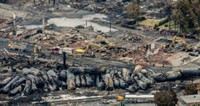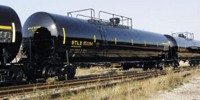Advertisement
Grab your lab coat. Let's get started
Welcome!
Welcome!
Create an account below to get 6 C&EN articles per month, receive newsletters and more - all free.
It seems this is your first time logging in online. Please enter the following information to continue.
As an ACS member you automatically get access to this site. All we need is few more details to create your reading experience.
Not you? Sign in with a different account.
Not you? Sign in with a different account.
ERROR 1
ERROR 1
ERROR 2
ERROR 2
ERROR 2
ERROR 2
ERROR 2
Password and Confirm password must match.
If you have an ACS member number, please enter it here so we can link this account to your membership. (optional)
ERROR 2
ACS values your privacy. By submitting your information, you are gaining access to C&EN and subscribing to our weekly newsletter. We use the information you provide to make your reading experience better, and we will never sell your data to third party members.
Safety
Railroads Delay New Tank Car Standards
Potential for conflict is seen as federal government prepares to propose plan
by Glenn Hess
November 28, 2007
The freight railroad industry has agreed to delay implementation of new design specifications for tank cars carrying chlorine and anhydrous ammonia until April 1, 2008. The standard, which would have required heavier, thicker steel shells and extra padding, was scheduled to take effect on Jan. 1, 2008, for newly purchased tankers.
The Association of American Railroads (AAR) agreed to the delay at the request of the Federal Railroad Administration (FRA), which plans to propose new federal design standards for hazardous material tank cars during the first quarter of the new year.
The government's plan will target rail shipments of toxic inhalation hazards (TIHs), a group of chemicals that are extremely hazardous if released. Anhydrous ammonia and chlorine account for about 80% of such materials hauled by rail.
AAR Assistant Vice President Kelly Donley says her organization intends to push ahead with its own plan and acknowledges that "there will be potential for discrepancy" between what the government proposes and the industry's new tank car requirements. She points out that rule-making is a lengthy process and more stringent federal safety standards for tank cars might not be put into force for a few years.
"We don't know what those standards might be or at what point they will be phased in," Donley says. "Our tank car committee is anxious to keep moving forward in making tank cars as safe as possible and less vulnerable" to rupture and leakage in the event of an accident.
Railroads have been pushing for stronger tank cars to reduce their liability. The industry, Donley notes, would prefer not to transport chlorine, anhydrous ammonia, and other extremely dangerous chemicals, but it is required to do so by federal law. "As railroads, we have to carry the stuff even though we don't want to. In the absence of safer chemicals, putting in place the toughest, most rigorous standards is the only choice the industry has," she remarks.
FRA began to look for ways to improve tank car survivability after a freight train derailment in Minot, N.D., on Jan. 18, 2002 caused a massive anhydrous ammonia leak that resulted in one death and injuries to more than two dozen people. The administration's research has focused on strengthening the integrity of the tank car to reduce the probability that a collision, such as a side impact, will result in the release of a hazardous compound.
FRA also has joined forces with Dow Chemical, Union Pacific Railroad, and Union Tank Car to develop a next-generation tank car, a research project the companies launched in August 2006. The goal is to create a car that is up to 10 times stronger and more puncture-resistant than the current 50-year-old tank car design. Construction and testing of a prototype is expected to begin early next year.





Join the conversation
Contact the reporter
Submit a Letter to the Editor for publication
Engage with us on Twitter